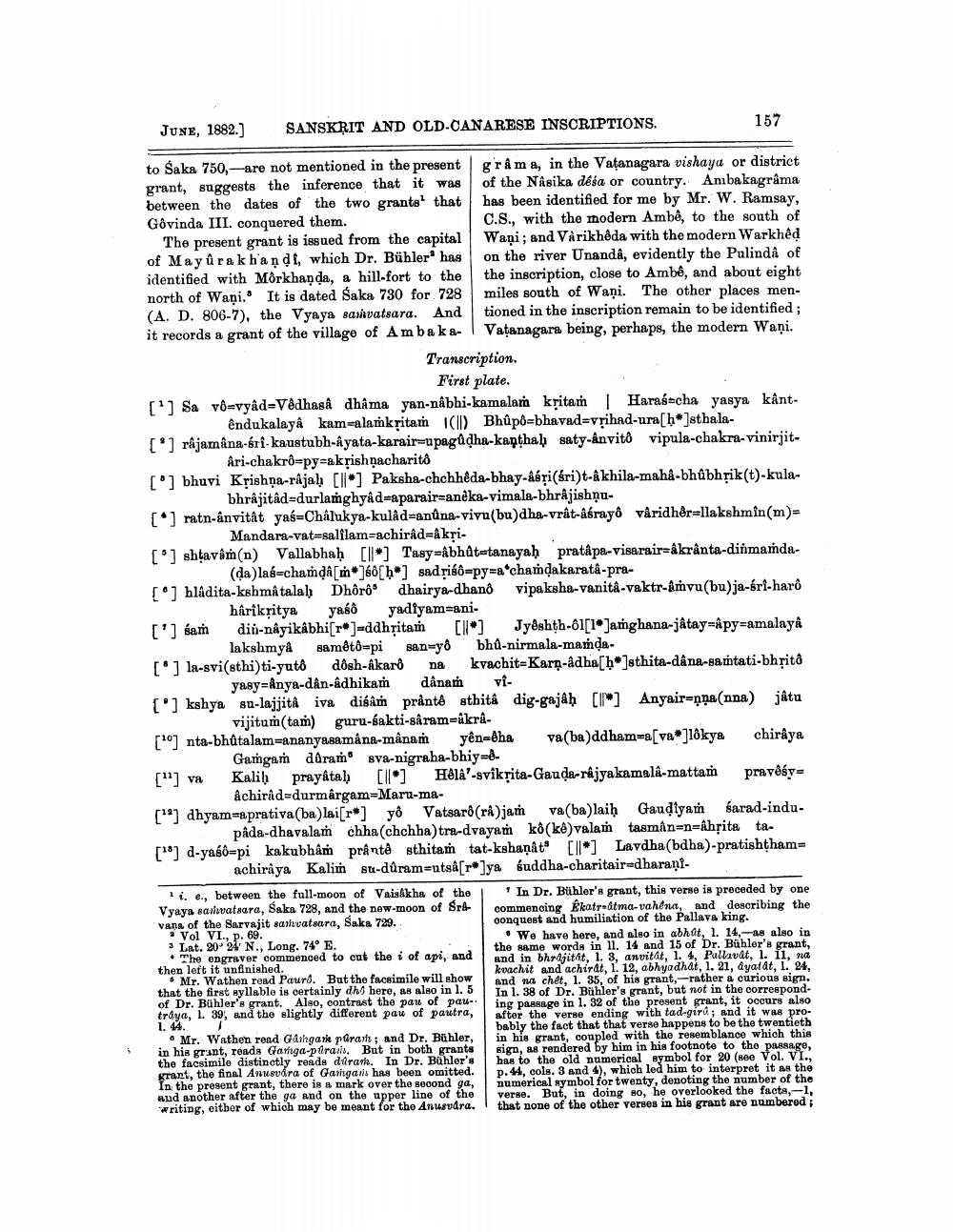________________
JUNE, 1882.)
SANSKRIT AND OLD-CANARESE INSCRIPTIONS.
157
to Saka 750,--are not mentioned in the present grå ma, in the Vatanagara vishaya or district grant, suggests the inference that it was of the Nâsika désa or country. Ambakagrama between the dates of the two grants that has been identified for me by Mr. W. Ramsay, Govinda III. conquered them.
C.S., with the modern Ambê, to the south of The present grant is issued from the capital Wani; and Varikhôda with the modern Warkhed of May û ra khandi, which Dr. Bühler has on the river Unandâ, evidently the Pulindê of identified with Môrkhanda, a hill-fort to the the inscription, close to Ambê, and about eight north of Waņi.' It is dated Saka 730 for 728 miles south of Waņi. The other places men(A. D. 806-7), the Vyaya sanhvatsara. And tioned in the inscription remain to be identified ; it records a grant of the village of Amba ka- | Vatanagara being, perhaps, the modern Waņi.
Transcription.
First plate. [?] Sa võ=vyâd=V&dhasa dhậma yan-nábhi-kamalar kritam | Haras-cha yasya kậnt
endukalayâ kam-alamkritam ICU) Bhủpô=bhavad=vrihad-ura[h*]sthala[*] râjamâna-bri-kaustubh-ayata-karair=upagûdha-kapthaḥ saty-ânvitô vipula-chakra-vinirjit
Ari-chakrð=py=akrishacharito [°] bhuvi Krishna-rajah [ll] Paksha-chchhêda-bhay-kéri(sri)t-akhila-mah-bhùbhrik(t)-kula
bhrajitâd=durlamghyâd-aparair=aneka-vimala-bhrâjishņu[*] ratn-ânvitât yas-Chalukya-kulâd=anûna-vivu(bu)dha-vrât-asrayô vâridhêrellakshmin(m)
Mandara-vat=salilam-achirâd-Akri. 1 shtavim(n) Vallabhah [ll] Tasy=Abhâtetanayah pratApa-visarair-Akranta-dinmamda
(da)las-chamda[m]66[bo] sad risô=py=a*chamdakaratá-pra[°] hladita-kshmâ talah Dhôrôo dhairya-dhanð vipaksha-vanita-vaktr-&mvu(bu)ja-bri-harð
hârikritya yako yadiyamrani['] sam dii-nâyikabhi[r]=ddhritam [ll] Jyêshth-61[1* Jamghana-jâtay=&py-amalaya
lakshmya samôtôæpi sanyo bhQ-nirmala-mama[] la-svi(sthi)ti-yutô dôsh-karo na kvachit-Karn-âdha[ho]sthita-dana-samtati-bhritô
yasy=Anya-dan-adhikam dânam vi[°] kshya su-lajjita iva diban prânte sthitâ dig-gajah [N] Anyair=nnanna) játu
vijitum(tam) guru-sakti-saram-akra[O] nta-bhůtalam=ananyasamána-mânam yên=éha va(ba)ddham=a[va*]lôkya chiraya
Gamgam ddram sva-nigraha-bhiy=d. ["] va Kalih prayâtah [l] Hela'-svikrita-Gauda-rajyakamala-mattam pravèsy=
âchiråd=durmârgam=Maru-ma["] dhyam=aprativa(ba)lai[r*] yô Vatsarô(ra)jam va(ba)laiḥ Gaudiyan sarad-indu
pâda-dhavalaṁ chha (chchha)tra-dvaya kô(kê)valam tasman-n=khpita ta. [%] d-yaśô=pi kakubham prantê sthitam tat-kshanat" [ll] Lavdha(bdha)-pratishtham
achiraya Kalim su-dúram=utså[r* ]ya suddha-charitair-dharaniTi, e., between the full-moon of Vaisakha of the In Dr. Bühler's grant, this verse is preceded by one Vyaya sailwatsara, Saka 728, and the new-moon of Srl commencing Ekatraatma-vaham, and describing the vana of the Sarvajit sa vatsara, Saka 729.
conquest and humiliation of the Pallava king. 9 Vol VI., p. 69.
• We have here, and also in abhat, l. 14, -as also in Lat. 20° 24 N., Long. 74° E.
the same words in 11. 14 and 15 of Dr. Bühler's grant, • The engraver commenced to cut the i of api, and
and in bhrijitat, 1. 3, anvitat, l. 4, Pallavit, l. ii, na then left it unfinished. Mr. Wathen read Pauro. But the facsimile will show
kuachit and achirat, 1. 12, abhyadhat, 1. 21, ayatát, l. 24, that the first syllable is certainly dht here, as also in l. 5
and na chet, 1. 35, of his grant, -rather a curious sign. of Dr. Bühler's grant. Also, contrast the pau of pau
In 1. 38 of Dr. Bühler's grant, but not in the correspond
ing passage in 1. 32 of the present grant, it occurs also trüya, L. 39, and the slightly different pau of pautra,
after the verse ending with tad-giru; and it was pro. 1. 4. 1
bably the fact that that verse happens to be the twentieth Mr. Wathen read Gårhgari pdrarh ; and Dr. Bühler, in his grant, coupled with the resemblance which this in his grint, reads Garga-purais. But in both grants sign, as rendered by him in his footnote to the passage, the facsimile distinctly reada durari. In Dr. Bühler's has to the old numerical symbol for 20 (Hee Vol. VI., kract, the final Anusvára of Ganga is has been omitted. p. 44, cols. 3 and 4), which led him to interpret it as the In the present grant, there is a mark over the second ga, numerical symbol for twenty, denoting the number of the and another after the ga and on the upper line of the verse. But, in doing so, he overlooked the facts,-1 a riting, either of which may be meant for the Anusudra. Ithat none of the other verses in his grant are numbered




